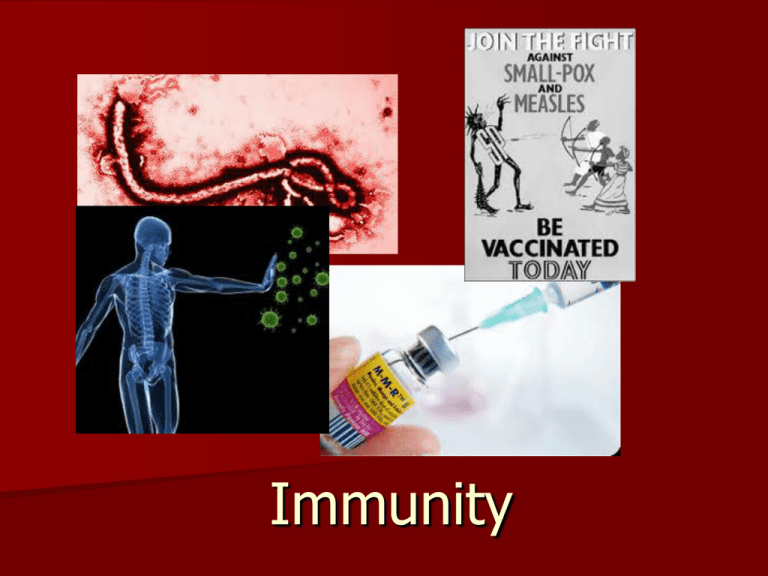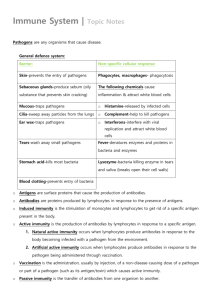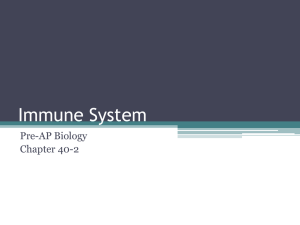Immunity Powerpoint
advertisement

Immunity What is immunity? Immunity is the body's ability to fight off harmful micro-organisms –PATHOGENSthat invade it. The immune system produces antibodies or cells that can deactivate pathogens. Fungi, protozoans, bacteria, and viruses are all potential pathogens. What advantage do pathogens have over humans? All have a short life span and reproductive time. So what? What is an infectious disease? An infectious disease is one in which minute organisms, invisible to the naked eye, invade and multiply within the body. Many of these organisms are contagious, that is they spread between people in close contact. The first person to identify microbes as causing disease was Robert Koch. We still use Koch’s Postulates in disease identification. Koch’s Postulates 1. Pathogen must be found in the host in every case. 2. Pathogen must be isolated from the host and grown in pure culture. 3. When placed in a healthy host, pathogen produced in pure culture must cause the disease in the host. 4. Pathogen must be isolated from the new host and shown to be the original pathogen. Endemic diseases are those found normally in a population. For example……. An epidemic disease is a disease that many people acquire over a short period of time. For example……… A pandemic disease is a world-wide epidemic disease. For example………. An antibiotic is a chemical substance derivable from a mold or bacterium that kills microorganisms and cures infections. The Immune System - includes all parts of the body that help in the recognition and destruction of foreign materials. White blood cells, phagocytes and lymphocytes, bone marrow, lymph nodes, tonsils, thymus, and your spleen are all part of the immune system. First-Line Defenses /Innate Immune System- The body's first line of defense against pathogens uses mostly physical and chemical barriers such as Skin – acts as a barrier to invasion Sweat – has chemicals which can kill different pathogens. Tears - have lysozyme which has powerful digestive abilities that render antigens harmless. Saliva – also has lysozyme. Mucus - can trap pathogens, which are then sneezed, coughed, washed away, or destroyed by chemicals. Stomach Acid – destroys pathogens Second-Line Defenses - If a pathogen is able to get past the body's first line of defense, and an infection starts, the body can rely on it's second line of defense. This will result in what is called an………. Inflammatory response causes Redness - due to capillary dilation resulting in increased blood flow Heat - due to capillary dilation resulting in increased blood flow Swelling – due to passage of plasma from the blood stream into the damaged tissue Pain – due mainly to tissue destruction and, to a lesser extent, swelling. Complement System Certain molecules on the surface of invading cells can activate complement system. Does not require prior exposure Marks cells for destruction using a cascade of 20-30 proteins Third-Line Defenses - Sometimes the second line The immune system recognizes, attacks, destroys, and remembers each pathogen that enters the body. It does this by making specialized cells and antibodies that render the pathogens harmless. Unlike the first line and second line defense the immune system differentiates among pathogens. For each type of pathogen, the immune system produces cells that are specific for that particular pathogen. of defense is still not enough and the pathogen is then heading for the body's last line of defense, the immune system. An antibody is a protein produced in response to an antigen. Antigens are macromolecules that elicit an immune response in the body. The most common antigens are proteins and polysaccharides. Lymph is a milky body fluid that contains a type of white blood cells, called lymphocytes, along with proteins and fats. Lymph seeps outside the blood vessels in spaces of body tissues and is stored in the lymphatic system to flow back into the bloodstream. There are more than 100 tiny, oval structures called lymph nodes. These are mainly in the neck, groin and armpits, but are scattered all along the lymph vessels. They act as barriers to infection by filtering out and destroying toxins and germs. White blood cells called macrophages trap and engulf cell debris and pathogens. Other white blood cells, called Lymphocytes - are a type of white blood cell capable of producing a specific immune response to unique antigens. They produce antibodies which are chemicals that mark pathogens for destruction. Once a white cell has left the blood vessel and migrated to the enemy, the next job is to EAT the microbe. The macrophage is a large phagocyte. A phagocyte is an eating cell (phago = "eating", cyte = "cell") which engulfs invaders. Immunity is the result of the action of two types lymphocytes, the B lymphocytes and the T lymphocytes. B cells produce antibodies that are secreted into the blood and lymph. T cells attack the cells that have antigens that they recognize. Killer T Cells (lymphocytes) recognize surface markers on other cells labeled for destruction. They, Killer T Cells, help to keep virus-infected or malignant cells in check. It has been estimated that during our lifetime, we will encounter a million foreign antigens capable of causing disease, and our bodies need the same amount of lymphocytes to defend against them. There will always be a different type of lymphocyte for each possible antigen. •Active (Adaptive) Immunity occurs when when one makes his/her own antibodies. This type of immunity is long term. •Getting the disease : If you get an infectious disease (like Chicken Pox), often times, that stimulates the production of MEMORY cells which are then stored to prevent the infection in the future. Vaccination: A vaccination is an injection of a weakened form of the actual antigen that causes the disease. The injection is too weak to make you sick, but your B lymphocytes will recognize the antigen and react as if it were the "real thing". Thus, you produce MEMORY cells for long term immunity. Passive Immunity occurs when the antibodies come from some other source. This type of immunity is short term. Breastmilk : Milk from a mother's breast contains antibodies. The baby is acquiring passive immunity. These antibodies will only last several weeks. BIG IDEAS Organisms had to evolve defenses against pathogens to increase odds of surviving Some defenses are general (skin, fevers, inflammatory response) Some are specific (producing antibodies, adaptive immunity, vaccinations)







